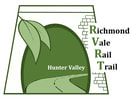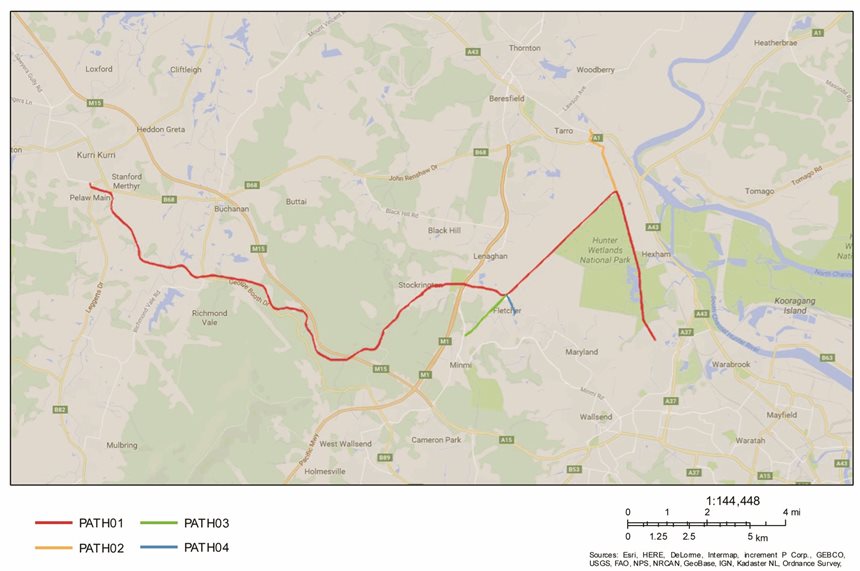Congratulations and Thanks to Billy Metcalf - Our ‘Founding President’Facebook Post – May 2nd 2024: https://www.facebook.com/richmondrailtrail/posts/pfbid0kimiffm8QdBaHCZeXwmbky6JfDvkhHtbJp5FPx31ATHn5bnWJLeei2BNMA6EEAvTl From Terry J. Lewin (RVRT Inc. President - RVRT Supporters’ Group) We held our (RVRT Inc.) RVRT Supporters’ Group AGM on Tuesday morning (April 30th 2024) at the Hunter Wetlands Centre. During that meeting, Billy Metcalf stepped down from his official role as President, after many years of dedicated and enthusiastic service. At the AGM, we acknowledged and honoured Billy’s outstanding contribution by offering him Life Membership of the RVRT Supporters’ Group as well as conferring upon him the honorary title of ‘Founding President’. Concurrently, we also collectively acknowledged all of the key contributors during the past 25 years (See below). It is difficult to say precisely when the RVRT Supporter’s Group began, but the history goes something like the following:
Billy Metcalf will continue to make an active contribution to the RVRT Supporters’ Group, and will remain as a Committee Member. Once again, Thanks and Well Done Billy! Thanks to all of our RVRT supporters. CONSTRUCTIVE COMMENTS AND FEEDBACK WELCOME. RVRT Inc. Contact Information: WEBSITE: https://www.richmondvalerailtrail.org.au/ FACEBOOK: https://www.facebook.com/richmondrailtrail/
0 Comments
An Unofficial Taster for the Proposed Shiraz to Shore Trail - March 2024 (Updated April 21st 2024).30/3/2024 An Unofficial Taster for the Proposed Shiraz to Shore Trail - March 2024 (Updated April 21st 2024).Facebook Post – March 30th 2024: https://www.facebook.com/richmondrailtrail/posts/pfbid0y5AvA4KMQmaEhonj7VNjFHFKqrEHHSE63zcvf73422Zi2ZtC8sZ9HSUUeHgzty2Yl Updated Facebook Post – April 21st 2024: https://www.facebook.com/richmondrailtrail/posts/pfbid02yUSjQb61EDhtkbVJNJps1wEuWejLCXrwSRtYfNtuuhN9Czqa7k7BnHTmYHV8jKY4l From Terry J. Lewin (RVRT Inc. Vice-President - RVRT Supporters’ Group)
To follow up on our previous RVRT Supporters' Group Posts, we have compiled a set of (West to East) Montages (see Pictures 3 to 8) highlighting the range of experiences that you might expect to have as you travel along the proposed 100+ km Shiraz to Shore Trail. As shown in Picture 2, the Shiraz to Shore Trail will be a multi-purpose shared pathway extending from (‘Shiraz’) Wine Country in the Hunter Valley to the Shores of Newcastle and Lake Macquarie (NSW, Australia). The proposed RVRT comprises approx. the middle third of the Shiraz to Shore Trail. You can also watch an associated short (3 Min.) YouTube video, illustrating (from West to East) the array of places that you will be able to visit and experience along the Trail. Link to video: https://youtu.be/n4Csg9SdK34 In reality, the proposed Trail will provide the conduit or spine for a broad range of activities and experiences. It will also help to promote the Hunter Region as a major cycle tourism destination, as well as providing day-to-day benefits for local communities, families and businesses. Once again - Congratulations to Hunter Joint Organisation of Councils (Hunter JO) - and the participating Councils and numerous stakeholder groups - for their ongoing efforts developing and refining the Shiraz to Shore Trail Proposal. “It’s definitely Time to make the Shiraz to Shore Trail (and RVRT) a Reality!” Thanks to all of our RVRT supporters. CONSTRUCTIVE COMMENTS AND FEEDBACK WELCOME.
Stay Tuned - Development of the 'Shiraz to Shore' Trail Proposal by Hunter JO is gathering pace.19/3/2024 Stay Tuned - Development of the 'Shiraz to Shore' Trail Proposal by Hunter JO is gathering pace.Facebook Post – March 19th 2024: (Updated) https://www.facebook.com/richmondrailtrail/posts/pfbid02sWffAjsYYeGwuSQ6PFyYptjSEN84Q3SxQKbgax2r9D43aLh97QmcpJFHfV9TMKDSl From Terry J. Lewin (RVRT Inc. Vice-President - RVRT Supporters’ Group)
Congratulations to Kim Carland, Tim Askew and Hunter Joint Organisation of Councils (Hunter JO) - and the participating Councils and numerous stakeholder groups - for their ongoing efforts developing and refining the proposed 100+ km Shiraz to Shore Trail Proposal. Hopefully, it won't be too long before we see a finalised Concept Plan, Business Case, Pitch Video, and overall Hunter Cycling Strategy - all designed to simultaneously promote the region as a major cycling tourism destination and to directly benefit local communities, families and businesses. Thanks to all of our RVRT supporters. CONSTRUCTIVE COMMENTS AND FEEDBACK WELCOME.
Benefits, Motivators, Deterrents and Potential Usage – Some Clues from Recent Cycling and Rail Trail Reports and Assessments: |
|||||||||||||||||||||||||||||||||||
| Download this blog post by clicking here... | |
| File Size: | 1405 kb |
| File Type: | |
As we move forward in our planning and advocacy for the Richmond Vale Rail Trail (RVRT) and the broader Shiraz to Shore Trail, we need to draw from and build upon the good work of other Australian organisations and networks.
Securing sufficient funding to build a quality and sustainable trail depends to a large extent on demonstrating strong community support, cost effective and culturally / environmentally sensitive approaches to construction and maintenance, and appropriate ongoing management and promotional strategies.
Securing sufficient funding to build a quality and sustainable trail depends to a large extent on demonstrating strong community support, cost effective and culturally / environmentally sensitive approaches to construction and maintenance, and appropriate ongoing management and promotional strategies.
However, it is often difficult to lay your hands on the right piece of external supporting documentation at the right time.
While this Post is generic in nature, it provides some additional broad support for our ongoing trail and cycling related activities by drawing on recent reports from around Australia.
While this Post is generic in nature, it provides some additional broad support for our ongoing trail and cycling related activities by drawing on recent reports from around Australia.
Benefits:
The significant economic, health and environmental benefits associated with cycling are graphically illustrated in Image 1, which forms the Executive Summary from the recent “2023 WeRide Australian Cycling and E-Scooter Economy Report” (November 2023) – to which we have added some Selected Extracts (see notes with image).
Additionally, comparisons with the previous report suggest that the “total direct output from cycling increased by 5% from 2020 to 2022, from an estimated $6.3bn to $6.7bn” … “With an increasing focus on physical and mental wellbeing and the benefits of outdoor recreational activity, it is expected that cycling will continue to grow” … “With an increase in local and state government expenditure on safe cycling infrastructure, it is expected that more Australians will take up cycling and also cycle more often”.
The significant economic, health and environmental benefits associated with cycling are graphically illustrated in Image 1, which forms the Executive Summary from the recent “2023 WeRide Australian Cycling and E-Scooter Economy Report” (November 2023) – to which we have added some Selected Extracts (see notes with image).
Additionally, comparisons with the previous report suggest that the “total direct output from cycling increased by 5% from 2020 to 2022, from an estimated $6.3bn to $6.7bn” … “With an increasing focus on physical and mental wellbeing and the benefits of outdoor recreational activity, it is expected that cycling will continue to grow” … “With an increase in local and state government expenditure on safe cycling infrastructure, it is expected that more Australians will take up cycling and also cycle more often”.
Motivators and Deterrents:
The recent survey conducted by WeRide also identifies some key Cycling Motivators and Deterrents (see Image 2 to Image 4).
In the 2022 survey:
The recent survey conducted by WeRide also identifies some key Cycling Motivators and Deterrents (see Image 2 to Image 4).
In the 2022 survey:
- “Exercise and fitness (96%) was the most popular reason for riding a bike followed by the impact of cycling on mental wellbeing (93%)”; while
- “73% of respondents noted that they would cycle more if there was more safe and connected infrastructure”.
Suggested Cycling-related Budgetary Actions for the Australian Government:
See Image 5 and associated notes from Bicycle Network (November 2021).
While the ‘Five Essential Budget Items’ recommended here were nominally for 2022/23, they are equally as important for the upcoming 2024/2025 Federal Budget (e.g., focusing on active transport, active tourism, behaviour change programs for young people, a national bike incentive scheme, and a safer national vehicle fleet).
See Image 5 and associated notes from Bicycle Network (November 2021).
While the ‘Five Essential Budget Items’ recommended here were nominally for 2022/23, they are equally as important for the upcoming 2024/2025 Federal Budget (e.g., focusing on active transport, active tourism, behaviour change programs for young people, a national bike incentive scheme, and a safer national vehicle fleet).
Illustrative Summary of Current and Potential Rail Trails:
See Image 6 and associated notes, which were based on material from Rail Trails Australia Website – clearly demonstrating the overall and growing popularity of rail trails, but also the tremendous opportunities, particularly in regional NSW – which will be partially realised by funding trails like the Shiraz to Shore (from Wine Country, via the RVRT, to the Shores of Newcastle and Lake Macquarie).
See Image 6 and associated notes, which were based on material from Rail Trails Australia Website – clearly demonstrating the overall and growing popularity of rail trails, but also the tremendous opportunities, particularly in regional NSW – which will be partially realised by funding trails like the Shiraz to Shore (from Wine Country, via the RVRT, to the Shores of Newcastle and Lake Macquarie).
We hope that you find this collection of recent materials of interest. Rail trails are obviously much more than cycleways (as illustrated by our many Posts during the past few years) and clearly we need to optimise both the local and the regional benefits – but it is also good to see where and how our efforts fit within broader national and state cycling and rail trail initiatives and programs.
Image 1: Executive Summary Figure (Page 4) from “2023 WeRide Australian Cycling and E-Scooter Economy Report” (November 2023).
An assessment prepared by Ernst & Young (“EY”) for We Ride Australia (‘WeRide’), which continues from EY’s 2021 study – “The WeRide Australian Cycling Economy Report”.
Link to Download Report:
https://www.weride.org.au/wp-content/uploads/2023/11/The_Australian_Cycling_and_e-scooter_Economy_in_2022_WeRide_and_EY_2023_Report_Final_web.pdf
An assessment prepared by Ernst & Young (“EY”) for We Ride Australia (‘WeRide’), which continues from EY’s 2021 study – “The WeRide Australian Cycling Economy Report”.
Link to Download Report:
https://www.weride.org.au/wp-content/uploads/2023/11/The_Australian_Cycling_and_e-scooter_Economy_in_2022_WeRide_and_EY_2023_Report_Final_web.pdf
Selected Extracts:
“In the largest ever study of its kind undertaken in Australia funded by governments, bicycle and E-Scooter industry, motoring and bicycle groups, the ‘2023 WeRide Australian Cycling and E-Scooter Economy Report’ has reinforced cycling’s importance in delivering triple bottom line outcomes with significant economic, health and environmental benefits”.
“The report revealed that in 2022 the sector generated:
“The extensive research conducted as part of the study found that a large proportion of adults would cycle more often if there was better infrastructure and programs to make cycling easier and safer”.
“The report also highlights the importance of cycling to the regions, for the first time providing a detailed picture of the positive impact of cycle tourism, valued at $1.9bn nationally” (WeRide’s Executive Officer Mr. Peter Bourke).
“With an increase in local and state government expenditure on safe cycling infrastructure, it is expected that more Australians will take up cycling and also cycle more often”.
“In the largest ever study of its kind undertaken in Australia funded by governments, bicycle and E-Scooter industry, motoring and bicycle groups, the ‘2023 WeRide Australian Cycling and E-Scooter Economy Report’ has reinforced cycling’s importance in delivering triple bottom line outcomes with significant economic, health and environmental benefits”.
“The report revealed that in 2022 the sector generated:
- More than 60,000 jobs (FTE) and $18.6 billion in economic and social contribution from cycling and e-scooter use.
- Cycling contributed $954 million in health and social benefits including $313 million in savings to the Australia health system, and
- Cycling avoided 514,096 tonnes of CO2e in greenhouse gas emissions, through replacing 3.9 billion kilometres of motor vehicle travel”.
“The extensive research conducted as part of the study found that a large proportion of adults would cycle more often if there was better infrastructure and programs to make cycling easier and safer”.
“The report also highlights the importance of cycling to the regions, for the first time providing a detailed picture of the positive impact of cycle tourism, valued at $1.9bn nationally” (WeRide’s Executive Officer Mr. Peter Bourke).
“With an increase in local and state government expenditure on safe cycling infrastructure, it is expected that more Australians will take up cycling and also cycle more often”.
Image 2: Cycling Motivating Factors – Summary (Page 22) – See Image 1 for Report Details and Link.
This study carefully profiled adult preferences for cycling in 2022 (N = 2,630 respondents).
“Exercise and fitness (96%) was the most popular reason for riding a bike followed by the impact of cycling on mental wellbeing (93%)”.
Almost two-thirds “(64%) of respondents are deterred from cycling as they don’t feel safe on the roads with motor traffic”.
See Image 3 for further details about Cycling Motivators and Image 4 for Cycling Deterrents.
This study carefully profiled adult preferences for cycling in 2022 (N = 2,630 respondents).
“Exercise and fitness (96%) was the most popular reason for riding a bike followed by the impact of cycling on mental wellbeing (93%)”.
Almost two-thirds “(64%) of respondents are deterred from cycling as they don’t feel safe on the roads with motor traffic”.
See Image 3 for further details about Cycling Motivators and Image 4 for Cycling Deterrents.
Image 3: Cycling Motivators – Figure Q (Page 22) – See Image 1 for Report Details and Link.
Responses to the Survey question: “To what extent do you agree or disagree that the following factors motivate, or make you want to ride a bicycle?”
Agree or Strongly Agree – Top 5: Physical Fitness (96%), Mental Wellbeing (93%), Fun/Enjoyable (93%), Better Environment (82%), Exploring (79%).
Responses to the Survey question: “To what extent do you agree or disagree that the following factors motivate, or make you want to ride a bicycle?”
Agree or Strongly Agree – Top 5: Physical Fitness (96%), Mental Wellbeing (93%), Fun/Enjoyable (93%), Better Environment (82%), Exploring (79%).
Image 4: Cycling Deterrents – Figure Q (Page 22) – See Image 1 for Report Details and Link.
Responses to the Survey question: “To what extent do you agree or disagree that the following factors stop you from riding your bicycle more?”
Agree or Strongly Agree – Top 5: Weather Conditions (75%), Don’t Feel Safe with Motor Traffic (64%), Not Enough Safe and Connected Infrastructure (64%), High Speed Limits – Riding Unsafe (59%), Too Many Heavy Vehicles (58%).
Responses to the Survey question: “To what extent do you agree or disagree that the following factors stop you from riding your bicycle more?”
Agree or Strongly Agree – Top 5: Weather Conditions (75%), Don’t Feel Safe with Motor Traffic (64%), Not Enough Safe and Connected Infrastructure (64%), High Speed Limits – Riding Unsafe (59%), Too Many Heavy Vehicles (58%).
Image 5: Five Essential Budget Items “that would benefit Australia in its shift towards a sustainable active transport friendly future”.
Federal pre-budget submission 2022/23 (November 2021) from Bicycle Network. Link to Download Report:
https://www.bicyclenetwork.com.au/wp-content/uploads/2021/12/2022-2023_Federal_Budget_Submission_Bicycle_Network_final.pdf
Selected Extracts:
1. An active transport budget (Page 7)
“We need a clear investment commitment, it’s that simple. At present, the Australian Government only funds active travel as part of larger infrastructure projects. We are recommending a change.” “Bicycle Network is pushing for the Australian Government to commit 5 per cent of the federal transport budget to active travel … It is time for Australia to match international efforts”.
2. A stimulus package to fund active tourism (Page 8)
“A focus on active tourism funding brings an exciting opportunity to get Australians out of their homes and back into their communities and regional areas” … “A $150 million per annum ‘local discoveries’ fund, offered to state governments in the form of grant packages, for repurposing existing space with active travel facilities, or to develop and expand current facilities (e.g. rail trails), as a means of stimulating domestic tourism and regional jobs. We already have the breathtaking scenery, let’s add some wheels to it”.
Federal pre-budget submission 2022/23 (November 2021) from Bicycle Network. Link to Download Report:
https://www.bicyclenetwork.com.au/wp-content/uploads/2021/12/2022-2023_Federal_Budget_Submission_Bicycle_Network_final.pdf
Selected Extracts:
1. An active transport budget (Page 7)
“We need a clear investment commitment, it’s that simple. At present, the Australian Government only funds active travel as part of larger infrastructure projects. We are recommending a change.” “Bicycle Network is pushing for the Australian Government to commit 5 per cent of the federal transport budget to active travel … It is time for Australia to match international efforts”.
2. A stimulus package to fund active tourism (Page 8)
“A focus on active tourism funding brings an exciting opportunity to get Australians out of their homes and back into their communities and regional areas” … “A $150 million per annum ‘local discoveries’ fund, offered to state governments in the form of grant packages, for repurposing existing space with active travel facilities, or to develop and expand current facilities (e.g. rail trails), as a means of stimulating domestic tourism and regional jobs. We already have the breathtaking scenery, let’s add some wheels to it”.
3. Behaviour change programs for young people (Page 9)
“Many young people currently use bikes for recreation, but do not ride for transport purposes, such as travelling to school. Moreover, they do not learn important road safety behaviours in a controlled environment. This is why a national bike focussed behaviour change program is critical for ensuring we foster generations of bike-positive kids”.
4. A national bike incentive scheme (Page 10)
“An Australian bike subsidy scheme doesn’t have to be complicated. We can develop the right framework by leveraging successful incentive program models in Sweden, Germany, Austria, and the UK, which have demonstrated increased rates of active travel, reduced rates of transport-related emissions, and increased participation from new female riders”.
5. A safer national vehicle fleet (Page 11)
“We need to start taking real action on vulnerable road user deaths” … “Bicycle Network recommends that the Australian government provide heavy vehicle operators with an assistance package to ease financial pressures associated with procuring and fitting critical safety technologies”.
“Many young people currently use bikes for recreation, but do not ride for transport purposes, such as travelling to school. Moreover, they do not learn important road safety behaviours in a controlled environment. This is why a national bike focussed behaviour change program is critical for ensuring we foster generations of bike-positive kids”.
4. A national bike incentive scheme (Page 10)
“An Australian bike subsidy scheme doesn’t have to be complicated. We can develop the right framework by leveraging successful incentive program models in Sweden, Germany, Austria, and the UK, which have demonstrated increased rates of active travel, reduced rates of transport-related emissions, and increased participation from new female riders”.
5. A safer national vehicle fleet (Page 11)
“We need to start taking real action on vulnerable road user deaths” … “Bicycle Network recommends that the Australian government provide heavy vehicle operators with an assistance package to ease financial pressures associated with procuring and fitting critical safety technologies”.
Image 6: Illustrative Summary of Current and Potential Rail Trails – Extracted from Rail Trails Australia Website (https://www.railtrails.org.au/trails/ ). “Rail Trails Australia is a volunteer-driven, not-for-profit, organisation that strives for the creation and promotion of a rail trail network across the country”.
Their website currently provides useful practical information (e.g., location, status, accessibility, usage/suitability, length, surface, attractions) for 148 Open or Partially Open Rail Trails.
Their website currently provides useful practical information (e.g., location, status, accessibility, usage/suitability, length, surface, attractions) for 148 Open or Partially Open Rail Trails.
It also identifies 27 Potential Rail Trails, 18 of which are in NSW (including the RVRT) – which largely reflects the fact that NSW is well behind the other states in the development of rail trails and related community infrastructure. Indeed, as shown in the Table, NSW currently has the lowest number of open/partially open rail trails.
Of particular note, 17 of the potential NSW rail trails identified by Rail Trails Australia are outside of the Greater Sydney Area – so, there are plenty of opportunities for the NSW and Federal Governments to fund active transport and active tourism in regional areas (in line with Bicycle Network’s recommendations – see Image 5).
Furthermore, if the success of The Tweed section of the Northern Rivers Rail Trail (NRRT) is anything to go by, then new NSW Rail Trails should be very popular with locals and visitors alike.
“Since the Rail Trail’s opening in March, the Tweed has hosted 108,829 trail guests. On average, that’s 16,329 visitors per month, 3,726 people per week or 532 people daily. This achievement is nothing short of remarkable” (Mayor of Tweed Shire Chris Cherry, Media Release, 31st October 2023).
Cr Cherry said the success of the Tweed section of the NRRT could be attributed to the unique nature and outdoor recreation opportunities the trail provides, especially as a free, safe and family-friendly experience.
“The Rail Trail provides an opportunity to reconnect with nature, breathe in fresh air and soak in the breathtaking beauty of the Tweed’s landscapes and the charming village life at our seven rest stops,” she said.
Link: https://www.northernriversrailtrail.com.au/northern-rivers-rail-trail-welcomes-over-100000-guests-in-seven-months-2
Thanks to all of our RVRT supporters.
CONSTRUCTIVE COMMENTS AND FEEDBACK WELCOME.
Of particular note, 17 of the potential NSW rail trails identified by Rail Trails Australia are outside of the Greater Sydney Area – so, there are plenty of opportunities for the NSW and Federal Governments to fund active transport and active tourism in regional areas (in line with Bicycle Network’s recommendations – see Image 5).
Furthermore, if the success of The Tweed section of the Northern Rivers Rail Trail (NRRT) is anything to go by, then new NSW Rail Trails should be very popular with locals and visitors alike.
“Since the Rail Trail’s opening in March, the Tweed has hosted 108,829 trail guests. On average, that’s 16,329 visitors per month, 3,726 people per week or 532 people daily. This achievement is nothing short of remarkable” (Mayor of Tweed Shire Chris Cherry, Media Release, 31st October 2023).
Cr Cherry said the success of the Tweed section of the NRRT could be attributed to the unique nature and outdoor recreation opportunities the trail provides, especially as a free, safe and family-friendly experience.
“The Rail Trail provides an opportunity to reconnect with nature, breathe in fresh air and soak in the breathtaking beauty of the Tweed’s landscapes and the charming village life at our seven rest stops,” she said.
Link: https://www.northernriversrailtrail.com.au/northern-rivers-rail-trail-welcomes-over-100000-guests-in-seven-months-2
Thanks to all of our RVRT supporters.
CONSTRUCTIVE COMMENTS AND FEEDBACK WELCOME.
|
RVRT Inc. contact information:
WEBSITE: https://richmondalerailtrail.org.au/ FACEBOOK: https://www.facebook.com/richmondrailtrail/ Secretary & Treasurer: Sam Reich Email: rvrt.inc@gmail.com Telephone: 0418 402 644 (Sam) |
President: Billy Metcalfe
Email: wmetcalfe@bigpond.com Telephone: 0417 453 152 (Billy) Vice-president: Terry Lewin Email: Terry.Lewin@bigpond.com Telephone: 0404 439 616 (Terry) |
𝘼𝙪𝙨𝙩𝙧𝙖𝙡𝙞𝙖 𝘿𝙖𝙮 2024 – 𝗖𝗼𝗺𝗺𝘂𝗻𝗶𝘁𝘆 𝙀𝙣𝙫𝙞𝙧𝙤𝙣𝙢𝙚𝙣𝙩𝙖𝙡 𝘼𝙬𝙖𝙧𝙙 to RVRT Supporters' Group from Cessnock City Council
| Download this blog by clicking here... | |
| File Size: | 4067 kb |
| File Type: | |
Somewhat to our surprise, on January 26th 2024 the RVRT Supporters' Group received an Australia Day Community Environmental Award from Cessnock City Council, based on our longstanding and ongoing efforts in "advocating for the preservation and development of the Richmond Vale Rail Trail (RVRT)".
A Plaque and Certificate (see Image 1) were presented to the Group’s representatives (see Image 2) at an Awards and Citizenship Ceremony held at the Performance Arts and Culture Centre (PACC) in Cessnock. [We also received a copy of Uncle Warren Taggart’s (2023) ‘Spirit of Place’ book about Wonnarua culture.]
A Plaque and Certificate (see Image 1) were presented to the Group’s representatives (see Image 2) at an Awards and Citizenship Ceremony held at the Performance Arts and Culture Centre (PACC) in Cessnock. [We also received a copy of Uncle Warren Taggart’s (2023) ‘Spirit of Place’ book about Wonnarua culture.]
Congratulations to RVRT Inc. Members and to everyone who has supported the RVRT’s development (see Image 3 for more detailed Acknowledgements and Thanks).
No doubt, this Award reflects both our consistent and persistent advocacy for the trail's development and our other 'environmental' contributions, such as the efforts of our dedicated NPWS-RVRT Landcare volunteers and our engagement with related regional initiatives such as the Shiraz to Shore project.
We have often highlighted the RVRT’s potential regional role as a ‘conservation conduit’ (e.g., https://www.richmondvalerailtrail.org.au/news/the-rvrt-as-a-conservation-conduit), which was further reinforced by the Newcastle Herald’s recent excellent series of articles (January 2024) about “The Hunter’s Hidden Gem: The Story of Hexham Wetland” (see https://www.richmondvalerailtrail.org.au/news/part-1-to-3-of-hexham-wetland-series-by-the-newcastle-herald and https://www.richmondvalerailtrail.org.au/news/the-hunters-hidden-gem-the-story-of-hexham-wetland-continued).
No doubt, this Award reflects both our consistent and persistent advocacy for the trail's development and our other 'environmental' contributions, such as the efforts of our dedicated NPWS-RVRT Landcare volunteers and our engagement with related regional initiatives such as the Shiraz to Shore project.
We have often highlighted the RVRT’s potential regional role as a ‘conservation conduit’ (e.g., https://www.richmondvalerailtrail.org.au/news/the-rvrt-as-a-conservation-conduit), which was further reinforced by the Newcastle Herald’s recent excellent series of articles (January 2024) about “The Hunter’s Hidden Gem: The Story of Hexham Wetland” (see https://www.richmondvalerailtrail.org.au/news/part-1-to-3-of-hexham-wetland-series-by-the-newcastle-herald and https://www.richmondvalerailtrail.org.au/news/the-hunters-hidden-gem-the-story-of-hexham-wetland-continued).
It’s nice to receive some external recognition for our collective efforts. In celebration of this Environmental Award, Image 4 presents a small cross-section of photos (from the past few years) of our Members, NPWS-RVRT Landcare Volunteers, and Supporters.
Some additional photos
Thanks (again) to all of our RVRT supporters.
|
RVRT Inc. contact information:
WEBSITE: https://richmondalerailtrail.org.au/ FACEBOOK: https://www.facebook.com/richmondrailtrail/ Secretary & Treasurer: Sam Reich Email: rvrt.inc@gmail.com Telephone: 0418 402 644 (Sam) |
President: Billy Metcalfe
Email: wmetcalfe@bigpond.com Telephone: 0417 453 152 (Billy) Vice-president: Terry Lewin Email: Terry.Lewin@bigpond.com Telephone: 0404 439 616 (Terry) |
In the Media
Archives
March 2024
February 2024
January 2024
November 2023
October 2023
August 2023
July 2023
June 2023
May 2023
February 2023
December 2021
July 2018
September 2017
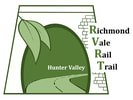
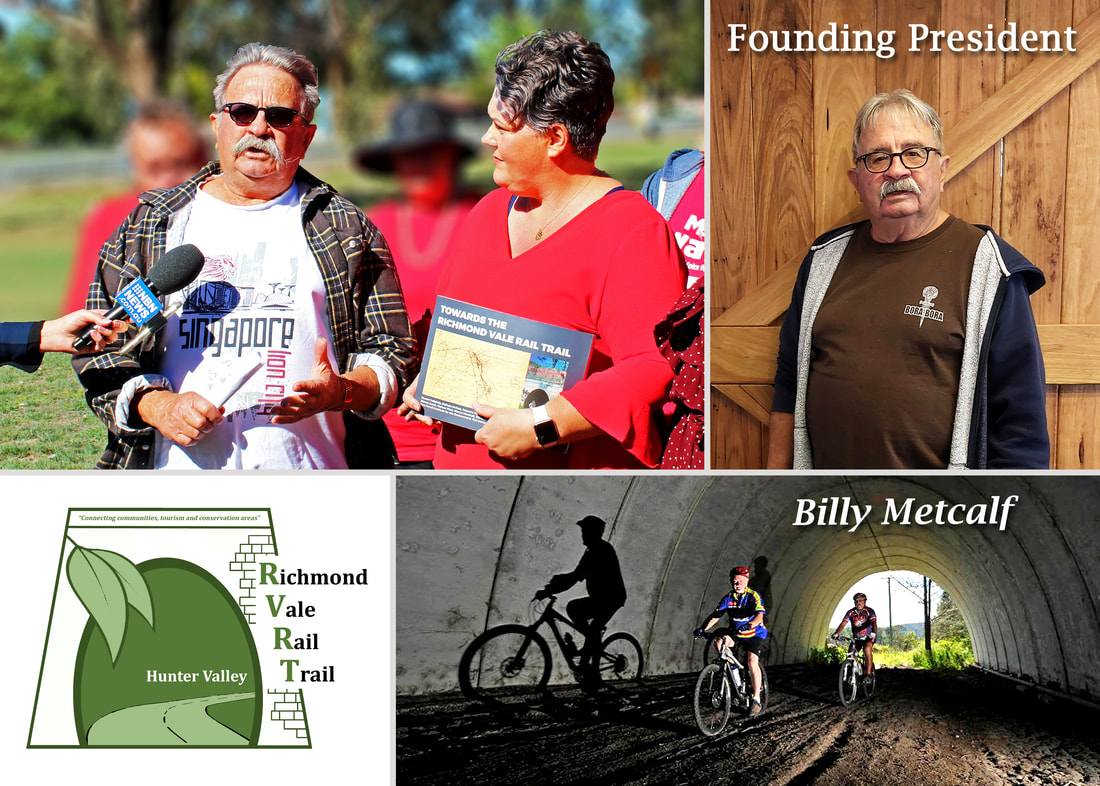
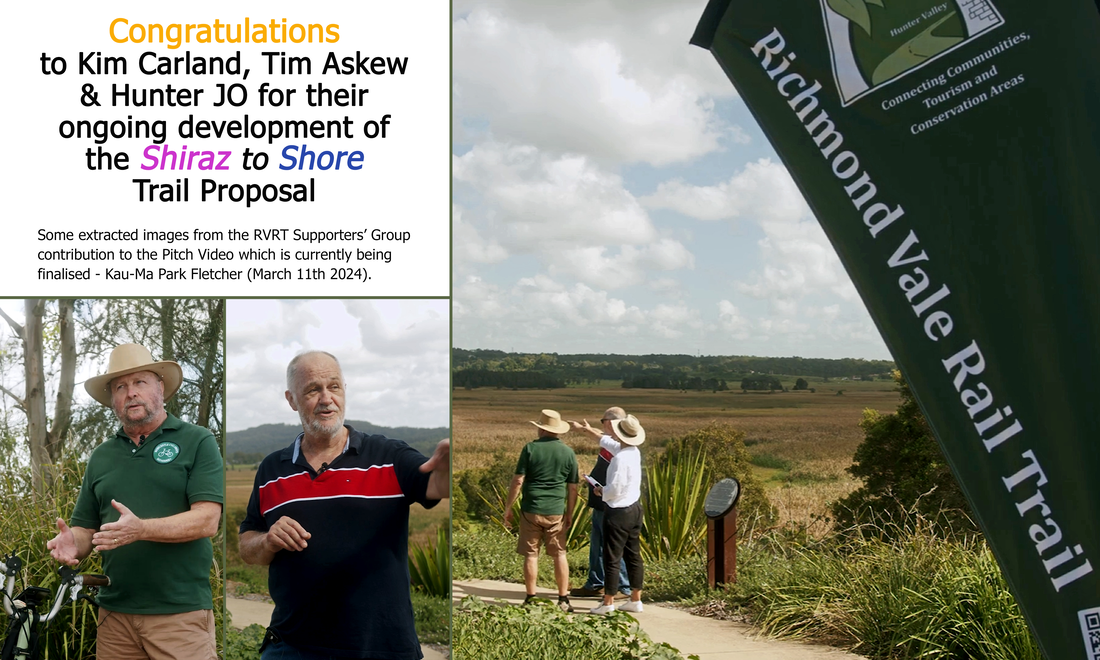
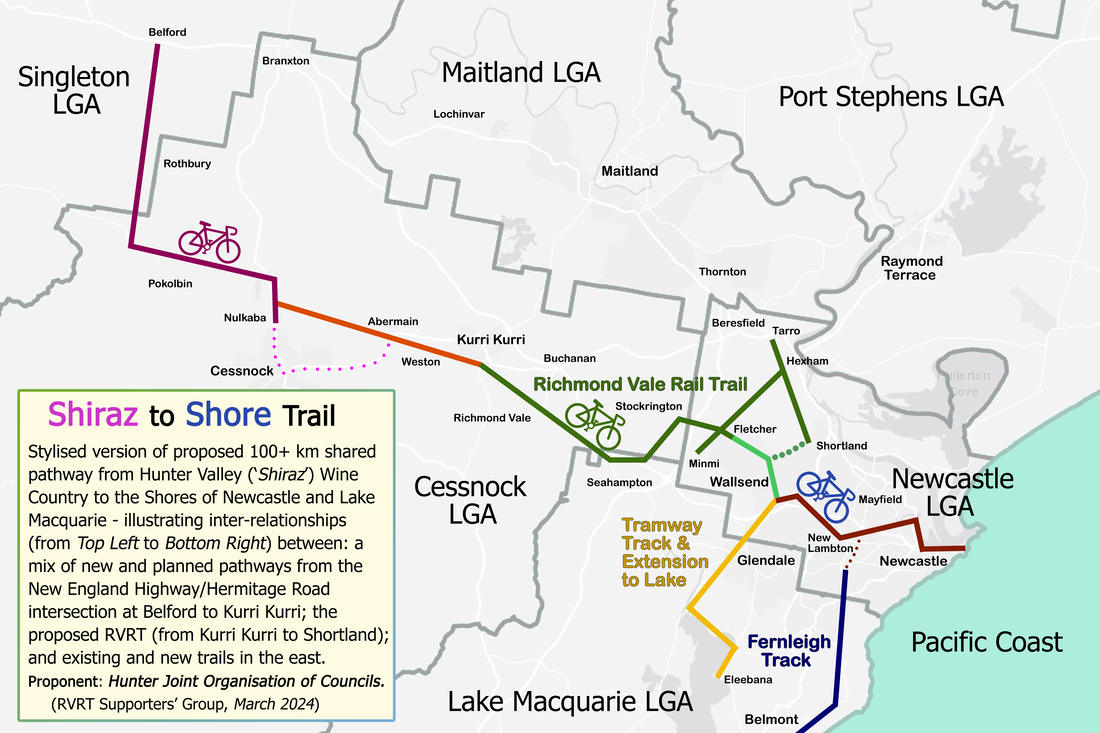
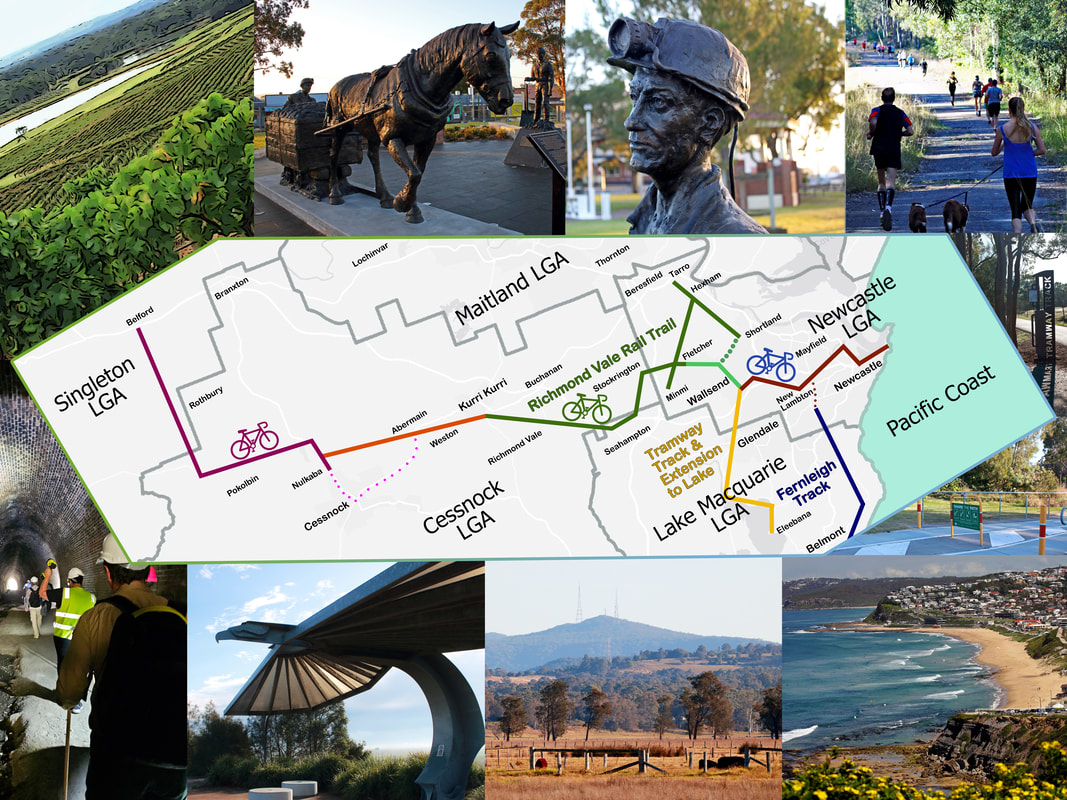
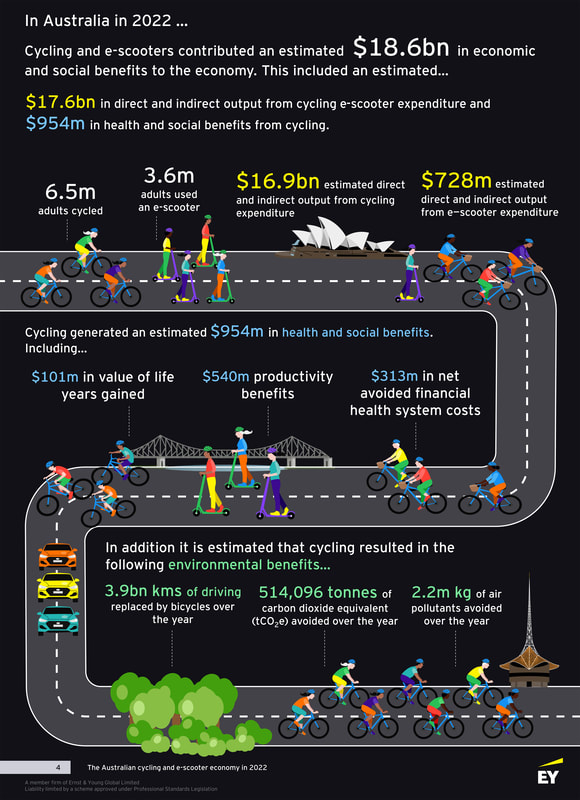
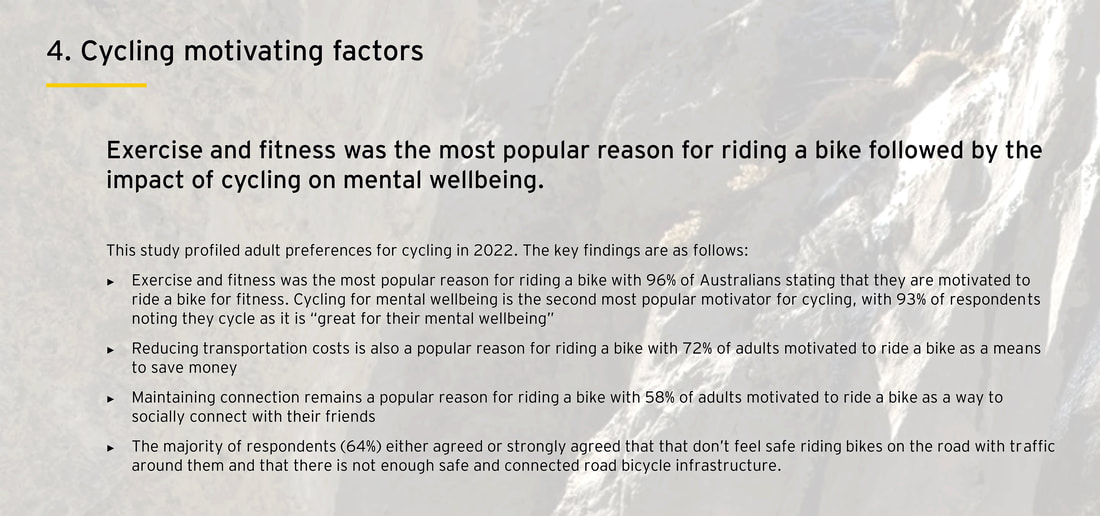
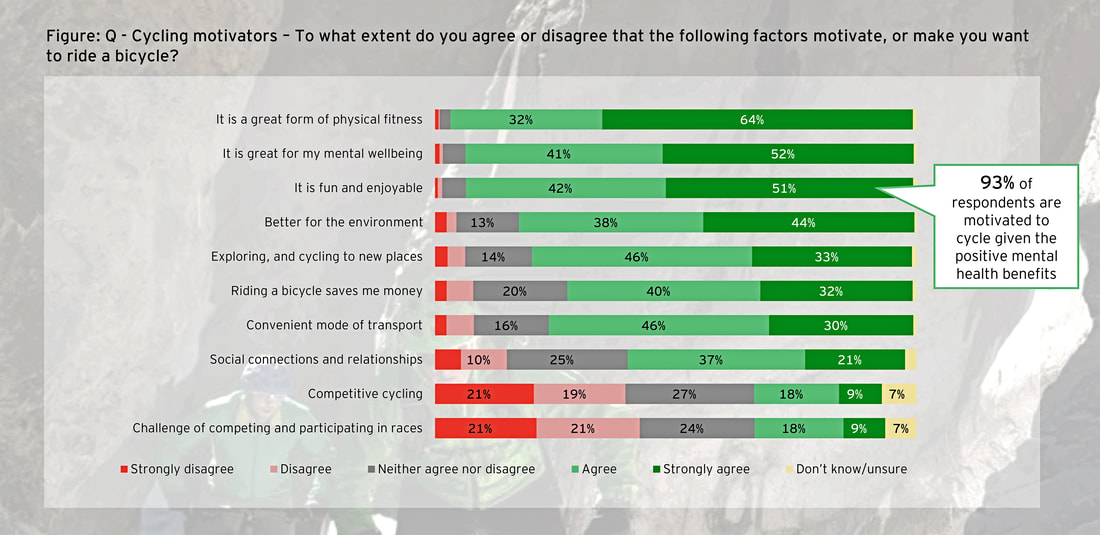

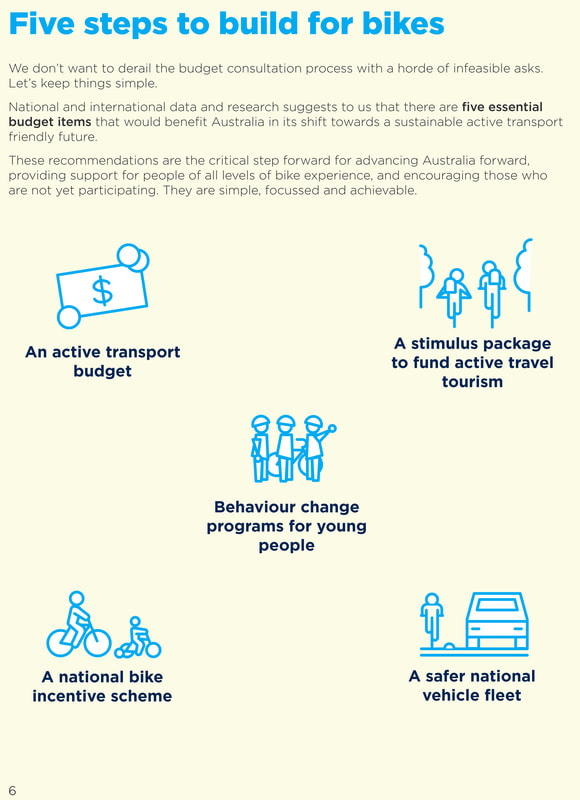
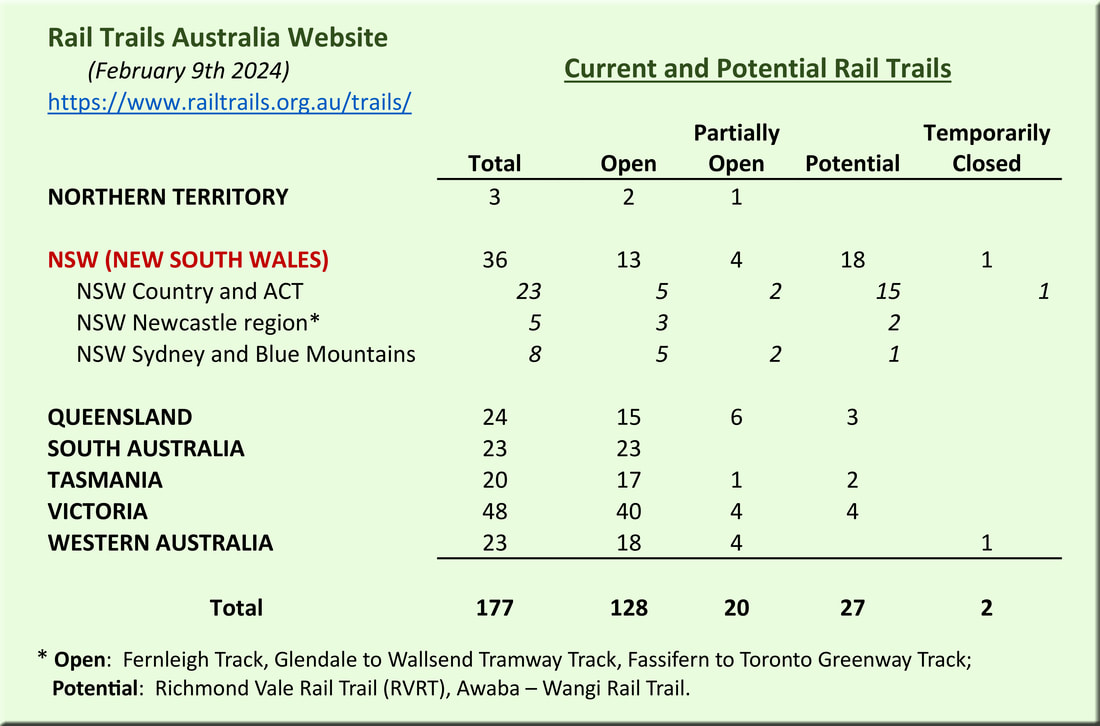

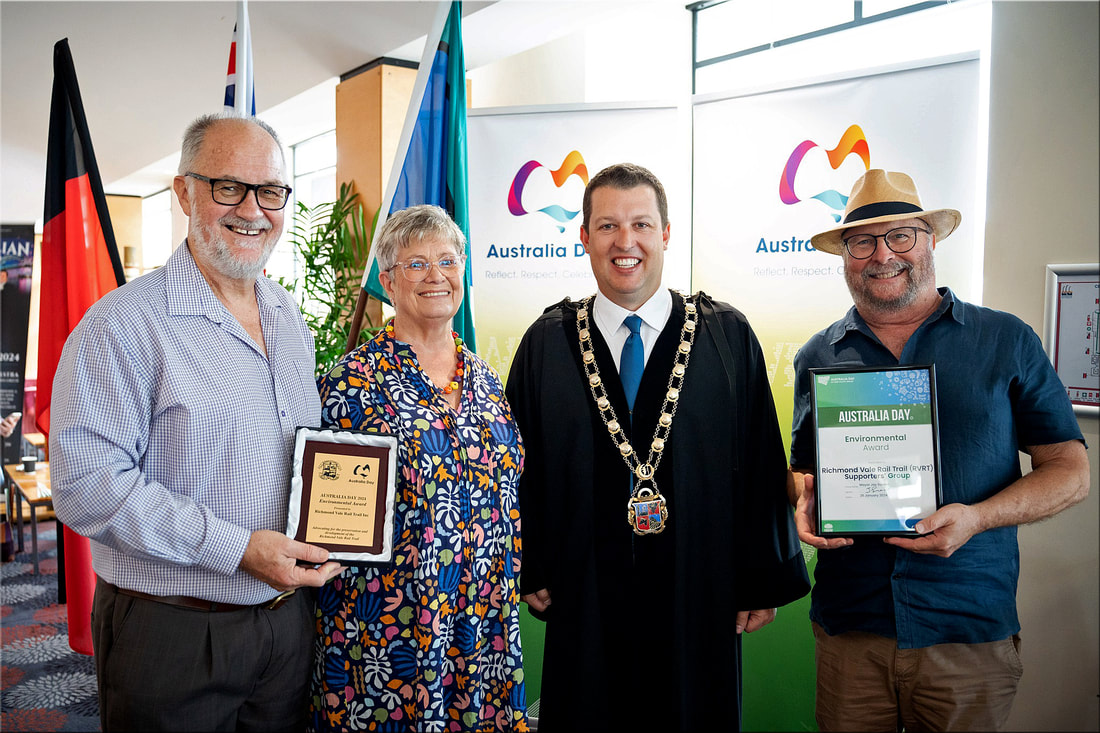
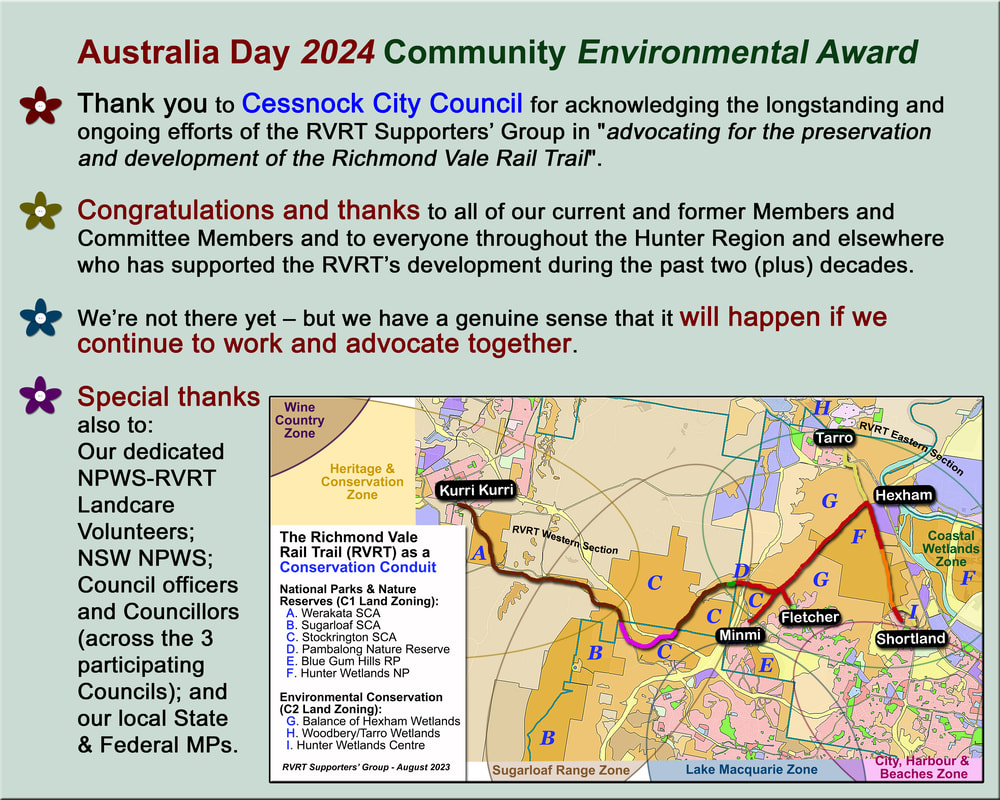
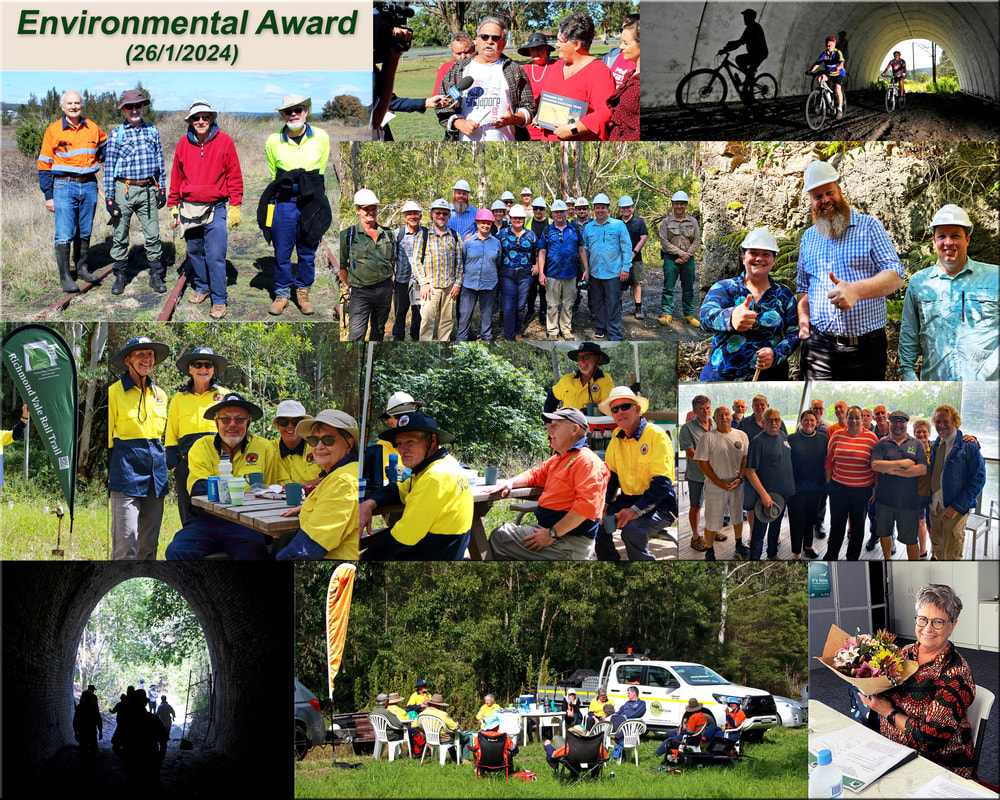
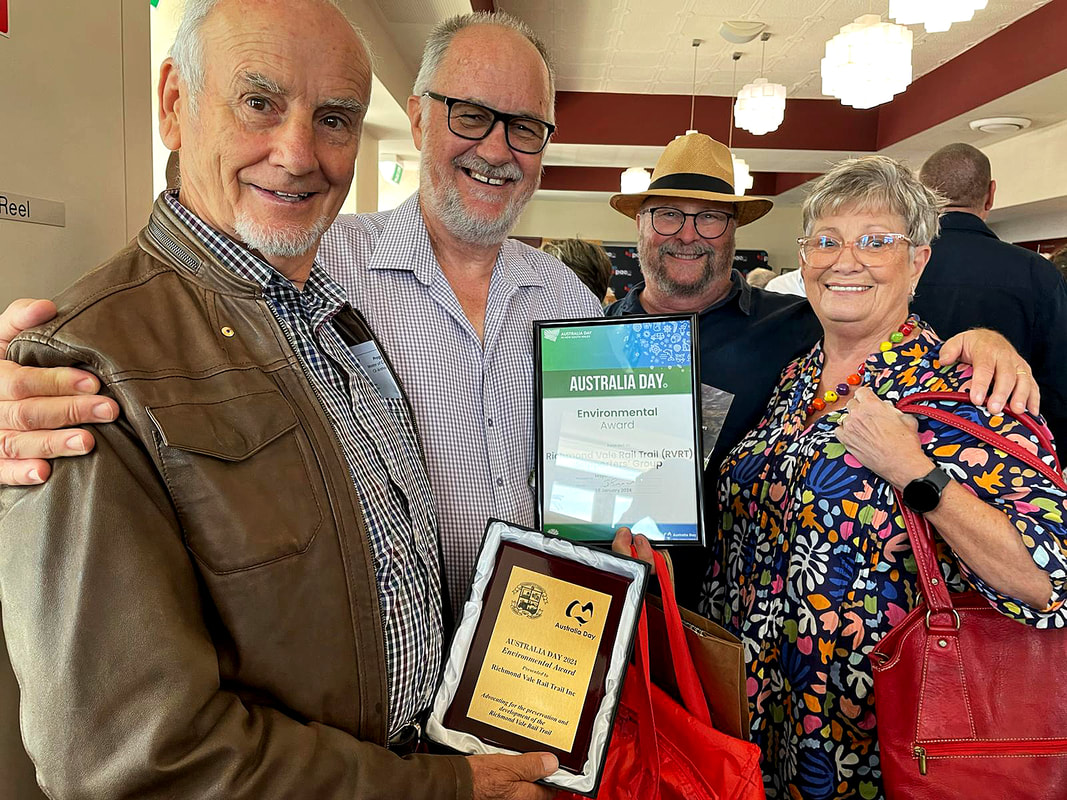
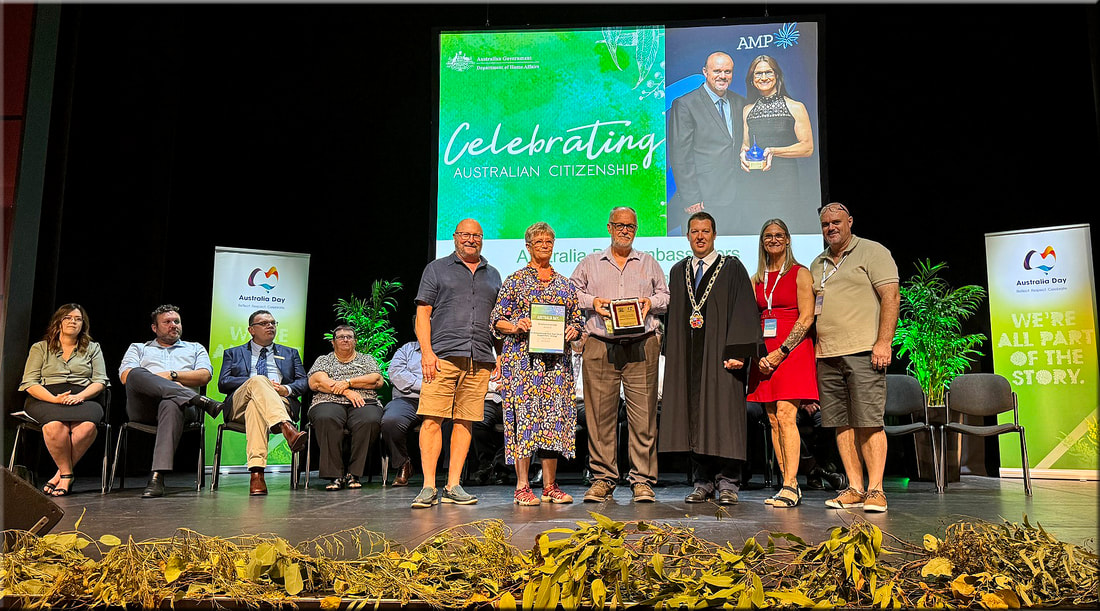
 RSS Feed
RSS Feed
